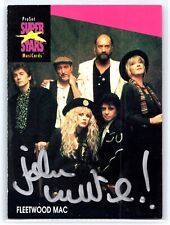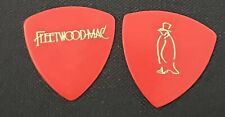|
1975
Will You Ever Win In the previous seven and a half years of Fleetwood Mac's existence, the band had undergone nine different personnel changes: some lasting a few weeks, some a year or two. While its artistic standards remained high; what the band lacked, if anything, was stability. So in the beginning of 1975 no one could have forseen that the next personnel change would allow the band to have not only a stable lineup for the next dozen years or so, but also be more-or-less guaranteed hitmaking status! And as the years went by, to most American ears anyway, this lineup would come to be regarded as the "original" Fleetwood Mac, however far from the truth that status might be. The story of how the tenth lineup came about has practically become a rock legend all its own. I recommend the reader to Mick Fleetwood's books Fleetwood: My Life and Adventures in Fleetwood Mac and My Twenty-Five Years In Fleetwood Mac, for the full story. Briefly, however, in late 1974, while Mick was checking out potential studios in the Los Angeles area for a place to record the next Fleetwood Mac album, he entered Sound City and was knocked out by the skill of a young guitarist that the owner, Keith Olsen, played to demonstrate the studio's acoustics. When he asked to whom he was listening, Fleetwood was told that a local duo whose album Olsen had produced was responsible. The song he heard was "Frozen Love". The names of the artists: Lindsey Buckingham and Stevie Nicks! Mick kept these names in memory and when Bob Welch quit, Mick put the word out. Soon a meeting between Fleetwood, the McVies, and the duo was arranged. Mick was initially only interested in hiring Buckingham, since after all the immediate need was for a guitarist/songwriter to replace Welch. Plus he was concerned with how Christine might feel about having another woman in the band. But once he realized that Buckingham and Nicks were a package deal, and after receiving assurances from Christine that she had no problem with it, both Lindsey and Stevie were offered the job. But before they accepted, Buckingham Nicks had one more thing to do. In the lean days following the release of the Buckingham Nicks album, Lindsey and Stevie kept food on the table with Stevie waiting tables while Lindsey did session work, all the while keeping the dream of a second album alive. Their first album had developed a cult following in certain areas, most notably in Birmingham, Alabama. Their last act as a duo, therefore, was to perform live before a sellout crowd of 7,000 there. After that, they were an integral part of Fleetwood Mac. Meanwhile, control of Fleetwood Mac's pre-Reprise back catalog in America passed from Epic to Sire Records (distributed by ABC Records). At the end of January, yet another compilation double album, Vintage Years , came out. Unlike its unimaginative Epic predecessors, Vintage Years at least contained songs that were generally unavailable (like "Man Of The World"), and in the case of "Rambling Pony", the B-side of the first UK single, a never-before-released-in-the-US track. It flirted briefly in the charts (going to 138) before sliding off. The new edition of Fleetwood Mac wasted no time in booking studio time at Sound City and after rehersals (after all, there was no audition for the newcomers), they recorded a new album. Produced by the band and Keith Olsen, it took all of ten days to make. After that, on May 15, 1975, the band hit the road. Fleetwood Mac , as the new album was called (it is also known as "The White Album", a passing nod to the Fab Four, and also to distinguish it from the Peter Green's Fleetwood Mac album), was released in July. It is a gem. The new members meshed quite well in their new home, and even though a significant number of songs were already written before the joining occurred ("Rhiannon", "Monday Morning" and "I'm So Afraid" were already slated for the abortive second Buckingham Nicks album; "Crystal" itself was on the first. Christine already had "Warm Ways" and "Over My Head" ready to go), they all sound as fresh as if they were written right then. The voices and instruments flowed into a wonderful whole. A damn nearly perfect album. And the stage performances in those days wove a magical web on the fans: they started with just the four of them on stage, and gradually Stevie emerged in her black top hat and lace, announcing "This is a song about a Welsh Witch" to sing "Rhiannon". Gradually, word spread. Within four weeks of release, the album had already reached higher than any previous Fleetwood Mac album had ever done in America, and by October 4, it had dented the top ten before sliding down. Then the first single "Over My Head" rode up the charts that Autumn and Fleetwood Mac started to rise again. It would continue that way in topsy-turvy fashion throughout 1976 and into 1977. Up until this point, or at any rate since the departure of Peter Green, singles had been a mere afterthought. Generally one would be released a month or two after the album that included it (or often not at all in Great Britain), it would be forgotten, and that would be that. The first single off of Fleetwood Mac, was also released two months after the album that spawned it. But where its predecessors stiffed almost immediately, this one started selling. Christine's wonderful "Over My Head", backed with the excellent "I'm So Afraid" (Buckingham's song of despair in the finest tradition of Peter Green) became the first Top 20 hit the band had in America, and the first hit single anywhere since 1970's "Green Manalishi". More would follow. Singles had once again become important. It was at this juncture (summer 1975) that Cliff Davis decided that the time was right to release Danny Kirwan's album Second Chapter in Britain (it was recorded in 1973). One would like to say that it's a collection of really terrific songs that Danny had written at his peak; sadly, such is not the case. His state of mind following his firing must have indeed been near-collapse: instead of being an album by a very talented guitarist and composer (and such Danny was in Fleetwood Mac), the record is a collection of overly-sentimental, almost wimpy, tracks that make 1971's "Dragonfly" seem like heavy metal! Kirwan's guitar--always his forte--is buried in the mix. The only song that has anything like a tempo is the bizarre "Ram Jam City" (also released as a single), called by critics at the time a "Scottish bluegrass" number. It's a throwaway. It was not released in the US 'til November, and when it was, one song, "Best Girl In The World", was omitted from the album for unknown reasons. In October the second single was released in the UK and it wasn't even really Kirwan's! Cliff Davis had shrewdly released the 1969 Fleetwood Mac single, "Man Of The World", again as an A-side, backed with the Kirwan album's title song, "Second Chapter". It didn't help. Neither did the interesting book-like cover artwork. Second Chapter remains a sad testimony to a career gone haywire. On a more positive note, 1975 also marks the recording debut of a young man with a new employer. This man's influence would become prominent in a future edition of Fleetwood Mac in much the same way as his new employer had for previous editions. The young man's name: Rick Vito (Vito recording debut as a studio axe-man actually happened five years earlier, and his most notable studio credit until now was playing on Todd Rundgren's 1972 hit LP Something/Anything ). And oddly enough, this start would in many ways parallel the origins of the band itself. Vito, born in Philadelphia, was one teenager among many in the audience during Fleetwood Mac's first US tour in 1968. His new employer: John Mayall! An extremely talented and versatile guitarist (Mayall always has had a great eye for aspiring talent), he first appears on the New Year, New Band, New Company album, released in February. Later in the year, he also played on folk great John Prine's fourth album Common Sense which includes the hilarious "Come Back To Us Barbara Lewis Hare Krishna Beauregard". Vito rounded off the year with December's Mayall album, Notice To Appear . And speaking of John Mayall, in Britain Decca released another in its "The World Of" series of albums in April, this time featuring the The Blues World of Eric Clapton. In it are several tracks culled from 1966's Bluesbreakers with Eric Clapton album and some singles that John McVie had a hand in. The Canadian version made its way south of the border to many an import album bin in the US. In September 1975, thanks to the ovewhelming success of the Fleetwood Mac album, the back catalog began to show some life as well. Suddenly four old Fleewood Mac albums, Then Play On , Bare Trees , Mystery To Me , and the previous year's Heroes Are Hard To Find were once again on the charts. And in November, Sire rereleased Fleetwood Mac In Chicago , and it also charted. One wonders if, however, given its title, this last release (as good as it is) wasn't mistaken for some sort of new live album by the recent fans...
|









